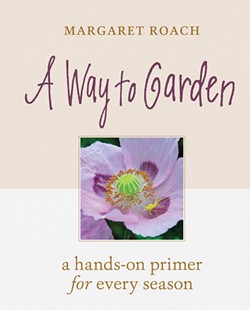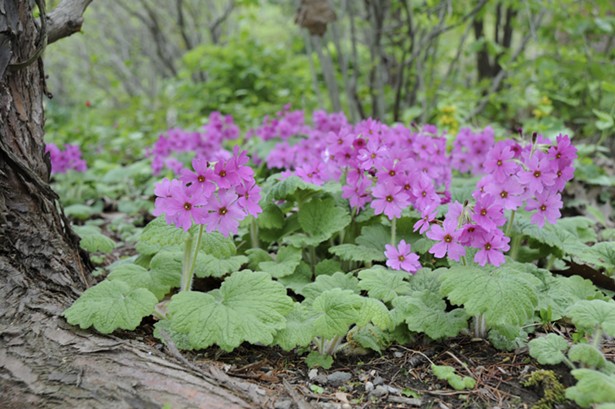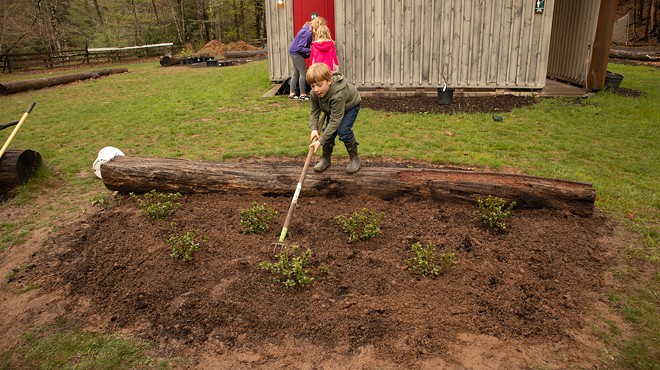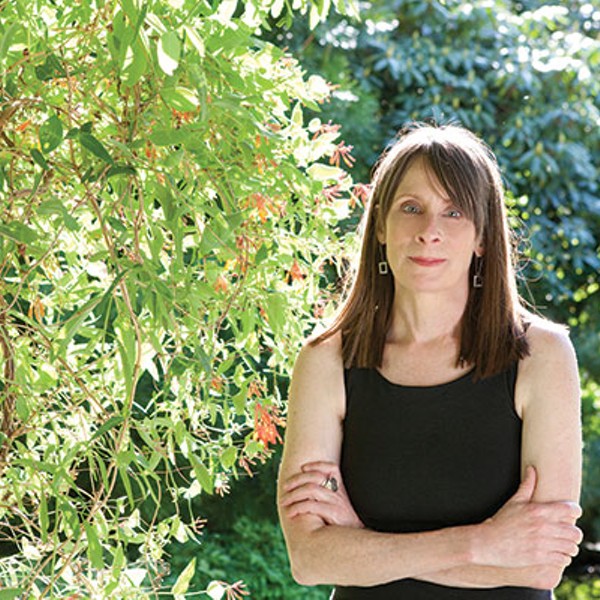In honor of the 21st anniversary of her gardening bible, A Way to Garden, local author and horticulturalist extraordinaire Margaret Roach just released an updated version of the book in April. The 2.0 edition shimmers with Roach's signature witty and sometimes razor-sharp commentary on the triumphs and woes of gardening, along with updated methodologies, and the cumulative wisdom of decades spent tending the same plot.
Roach's impressive resume includes writing for Newsday and the Martha Stewart empire, an 11-year stint as a blogger and talk show host, and authoring three books. Her website is a greenthumb encyclopedia for all current and aspiring gardeners, including a section dedicated to monthly garden chores, plus countless interviews with friends and fellow experts.
In the introduction to A Way to Garden, Roach writes, "By becoming a gardener, I accidentally—blessedly—landed myself in a fusion of science lab and Buddhist retreat, a place of nonstop learning and of contemplation, where there is life buzzing to the maximum and also the deepest stillness. It is from this combined chemistry that my horticultural how-to and 'woo-woo' motto derives." Delightful, practical, and highly readable, this guide book is an ode to the ever-evolving mystery and magic of gardening.
Tour Roach's garden oasis in Copake Falls during the open day and plant sale on May 11.
—Marie Doyon
Making Mosaics (Underplanting)
It is easier to bring home several flats of some extra-sturdy ground-covering perennial, plug it in under trees and shrubs, and check that bed off the list. Done! In fact, in the outermost beds, to serve as living mulch and reduce weeding chores under big groups of woody plants, that's what I did with Geranium macrorrhizum and some other strong but not invasive souls.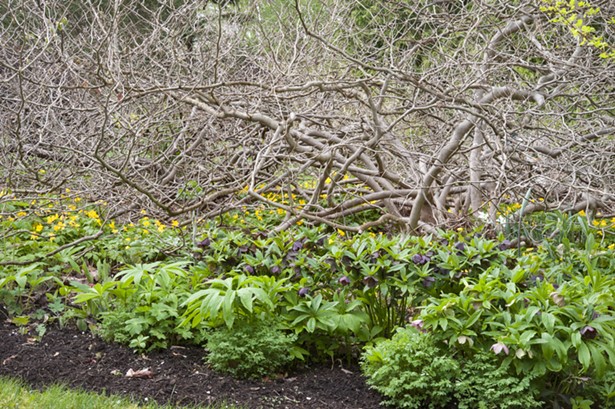
Near the house, where I come and go—as do visitors—that would be boring, no fun at all for a she's-gotta-have-it gardener. In high-profile areas, I make mosaics, not masses—layered, intermingling compositions aimed at visual interest over the longest possible season. They are a bit more work to tend than sheets of the stalwart geranium, but worth it. Here's how to do it:
No ring-around-the-rosie, thanks anyway Rather than circling the dripline of trees or shrubs (or a group of trees and shrubs) with ground covers and bulbs and such, you have to get all the way in there, even nearly right up against the trunk, to make it look unman-made, as if it just happened.
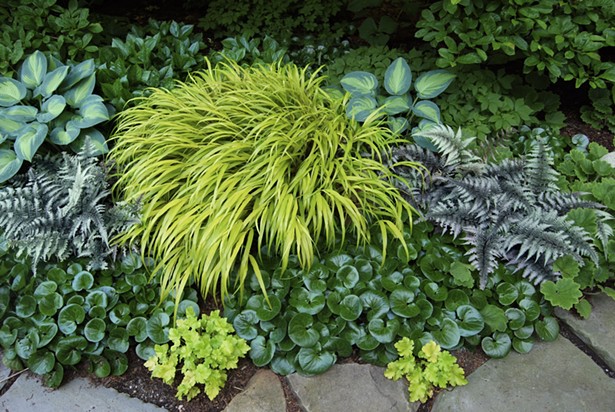
No polka dots (except at first) It's all about learning to "think mosaic," which doesn't mean polka dots of onesies, but sweeps and drifts and deliberate repetition of said sweeps and drifts. At first, though, no matter how many plants you buy or what you feed them, the new underplanting will look like polka dots. Which leads to the next lesson:
Patience is required This gardening nonsense is all about patience—frankly I think it's a patience-building practice more than anything else. Your bed will look better next year, and almost great three years after planting. After the fourth, you can start harvesting divisions to repeat your success elsewhere.
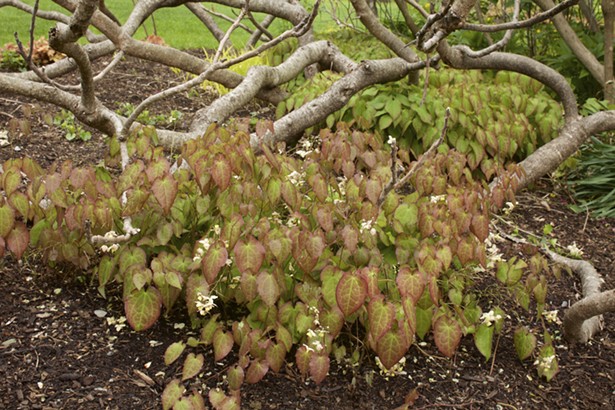
Notice I say "divisions," as in small pieces of plants When working in the root zone of trees and even established shrubs, I work with a small trowel or a hori-hori, and plant very small things. I use divisions made from older plants, or order "liners" from my local nursery (the baby plants they get wholesale in late winter, then normally pot up and grow on to sell). I ask them to order me a tray of liners and mark it up accordingly—but to skip the repotting and growing on. No digging with a shovel (or tiller, heaven forbid) in root zones. Again, patience is required, and a gentle hand, too.

Select a palette that relies on several key plants, with another (or a couple) as punctuation—little gems to pop up from the carpet. Buy or divide so you have lots of each mainstay to get started. The late-spring-to-fall palette under my oldest magnolia is glossy European ginger (Asarum europaeum), Hakonechloa macra 'All Gold', a very choice Japanese painted fern, and turquoise and gold Hosta 'June'. An all-native idea: At the must-visit native plant research facility and garden in Delaware called Mt. Cuba Center, creeping phlox (Phlox stolonifera), maidenhair fern (Adiantum spp.) foamflower (Tiarella cordifolia), and Pennsylvania sedge (Carex pensylvanica) intermingle as a long-lasting and winning combination.
Include ephemerals, whether early spring bulbs or perennials, that rise and take advantage of the sunshine before the canopy leafs out, then vanish underground or at least don't take up much space. Winter aconites, trilliums, Dutchman's breeches, bloodroot, twinleaf, Virginia bluebells—the list goes on. I get about six extra-early weeks of color from my underplantings, before my mainstay plants fill in, by using ephemerals lavishly.

Include some "ground cover" types, meaning plants that form thick mats (but not English ivy or pachysandra or vinca). For this part of the plan, I am partial to epimediums, European ginger, Hakonechloa, and hellebores.
Make space for some real gems These might include species peonies, choice hostas (I love gold ones for this purpose), or even bulbs—like an effusion of martagon lilies such as red-flowered 'Claude Shride'. What about an unexpected outburst from the bawdiest of primroses, Primula kisoana, with orchid-pink flowers and lovely scalloped, fuzzy foliage?
When choosing plants, remember that leaves are your best friend Plan on a mix of textures and colors, coming mostly from foliage (as the leaves will be there all season or even all year, the flowers just briefly). Think of the color range of heucheras alone you could employ, or hostas—foliage is hardly boring. Which relates to this lesson:
Texture is also a great ally. Work it I cannot imagine "mosaics" working without some linear things (grasses, or sedges), contrasted against some ferny things (like, well, ferns, or Aruncus aethusifolius), and against some larger-textured things (like bigger hostas, Astilboides tabularis, or the Northwest native Darmera peltata—which also offers extra-early pink flowers on naked stems). Speaking of large and textured: the Astilboides cousins in the genus Rodgersia are among my most prized shade ground covers.
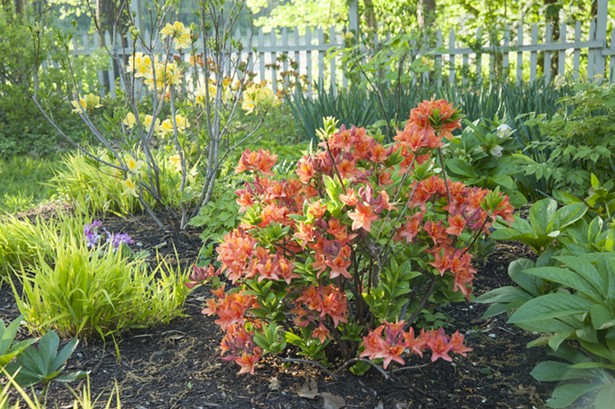
Once you've selected a palette, repeat, repeat, repeat Not just in the first area you underplant, but (if it works) in another area, where it may be all mulch right now, or a sea of a single ground cover. Soon your first mosaic will fill in and afford you divisions, and you will move on to making the next beautiful carpet.
Taken from A Way to Garden © 2019 by Margaret Roach. Published by Timber Press, Portland, Oregon. Used by permission of the publisher. All rights reserved.








